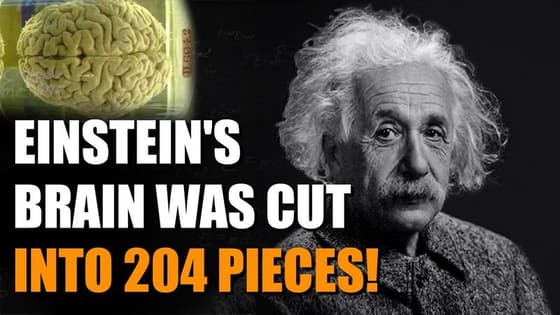
Did you know? Albert Einstein's brain was stolen, cut into 240 pieces! (WATCH)
The journey of Einstein's brain from Princeton Hospital to a beer cooler in Kansas, orchestrated by pathologist Thomas Harvey, epitomizes a saga of scientific curiosity and cultural fascination. After Harvey preserved, photographed, and dissected the brain into 240 pieces, it remained missing for 23 years until journalist Steven Levy's relentless pursuit led to its rediscovery.
Albert Einstein, the iconic physicist whose name has become synonymous with genius, left an indelible mark on the landscape of scientific inquiry. Yet, perhaps equally remarkable is the journey his brain undertook long after his passing. From Princeton Hospital to the beer cooler of a pathologist in Kansas, the story of Einstein's brain is a captivating tale of scientific curiosity and cultural fascination.

On April 18, 1955, Einstein's physical existence came to an end at Princeton Hospital. Little did anyone know that the pathologist on call that day, Thomas Harvey, would play a pivotal role in the posthumous saga of Einstein's most enigmatic organ. Harvey's actions, however controversial, would ensure that Einstein's brain would remain a subject of intrigue for decades to come.
Harvey's decision to preserve, photograph, and ultimately dissect Einstein's brain sparked both intrigue and controversy. The brain, cut into 240 pieces and meticulously cataloged, became the subject of scientific scrutiny and speculation. Harvey's clandestine preservation efforts, though initially secretive, would eventually thrust him into the spotlight as the guardian of Einstein's cerebral legacy.
For 23 years, Einstein's brain remained missing until journalist Steven Levy embarked on a quest to uncover its whereabouts. Tracking Harvey to Wichita, Kansas, Levy's persistence led him to the revelation that Einstein's brain resided not in a prestigious laboratory, but rather in a humble beer cooler. The image of the revered scientist's brain nestled among chilled beverages served as a surreal reminder of the enigmatic nature of scientific inquiry.
Describing the contents of the jars housing Einstein's brain, Levy painted a vivid picture of scientific curiosity. From "conch shell-shaped masses" to "pinkish-white strings resembling bloated dental floss," the physical remnants of Einstein's intellect captivated the imagination and fueled speculation about the neurological underpinnings of genius.
Harvey's subsequent studies of Einstein's brain, published in 1985, sought to unlock the secrets of intelligence hidden within its neural pathways. Claiming an abnormal proportion of neurons and glial cells, Harvey's findings ignited both excitement and skepticism within the scientific community. While some hailed Einstein's brain as a window into the mysteries of the mind, others, like Terence Hines of Pace University, dismissed such claims as unfounded.
Despite the scientific debate surrounding its significance, Einstein's brain has transcended the realm of academia to become a cultural phenomenon. From novels to comic books, its story has inspired artists and playwrights alike, each seeking to unravel the mysteries concealed within its grey matter.
In the end, the journey of Einstein's brain serves as a testament to the enduring allure of scientific discovery and the profound impact of one man's intellect on the world stage. Whether housed in a prestigious laboratory or nestled within a beer cooler, Einstein's brain continues to captivate the imagination and fuel the quest for knowledge in pursuit of understanding the essence of genius.